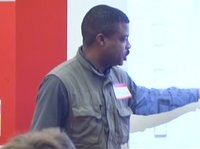New York QS Show&Tell #4 – Recap
Steven Dean
January 6, 2010

Before the holidays we held our 4th NY QS Show&Tell at Meetup HQ. Thanks to our hosts Scott Heiferman and Camille Alexander from Meetup and a special thanks to our new videographer, Evan Creem.
Self-Tracking Tools
 Garfield started us off by describing Jerry Seinfeld’s “don’t break the chain concept” as a success formula for writing a joke a day. He went on to show us a method of using forms and spreadsheets with Google docs and then walked us through one of the best iPhone apps for tracking daily activities, Daily Tracker. Garfield’s presentation on Vimeo.
Garfield started us off by describing Jerry Seinfeld’s “don’t break the chain concept” as a success formula for writing a joke a day. He went on to show us a method of using forms and spreadsheets with Google docs and then walked us through one of the best iPhone apps for tracking daily activities, Daily Tracker. Garfield’s presentation on Vimeo.
Get Paid to Lose Weight
![]() David from HealthWage presented his new venture that ties incentives to behavior change. David showed us several of the self-tracking features of the site to get feedback from the group. David’s presentation on Vimeo.
David from HealthWage presented his new venture that ties incentives to behavior change. David showed us several of the self-tracking features of the site to get feedback from the group. David’s presentation on Vimeo.
The Standards Project
 Jake Lodwick shared with us his personal experience developing a self-monitoring and goal-setting system to help him address his lack of a sense of what to do each day. This is a fascinating look into self-examination and then doing something about the things we’re unhappy with about ourselves by using self-experimentation and self-tracking methods. Jake’s blog on the project. Jake’s presentation on Vimeo.
Jake Lodwick shared with us his personal experience developing a self-monitoring and goal-setting system to help him address his lack of a sense of what to do each day. This is a fascinating look into self-examination and then doing something about the things we’re unhappy with about ourselves by using self-experimentation and self-tracking methods. Jake’s blog on the project. Jake’s presentation on Vimeo.
Geo-Tracking

Ted Power tapped into InstaMapper for real-time GPS tracking of his cellphone. He has about a year of data that tracks his location every 20 seconds. He showed us a mapping of his daily commute and even a kayak trip down the East River. Ted also pulled the data into Processing to experiment with visualizing it on a map. Ted’s presentation on Vimeo.
Computerized Text Analysis

Jamie Pennebaker took us along a fascinating journey into the nature of language and words. Jamie, a professor in the Dept. of Psychology at UT Austin, has developed tools to analyze any text to identify positive words, negative words, and emotions by focusing on what he calls junk words: pronouns, prepositions, articles, conjunctions, auxiliary words. Get started by analyzing your own Twitter feed at AnalyzeWords.com, get the Linguistic Inquiry and Word Count (LIWC) text analysis software, or have fun with some of his brief demonstrations. Jamie’s presentation on Vimeo.


